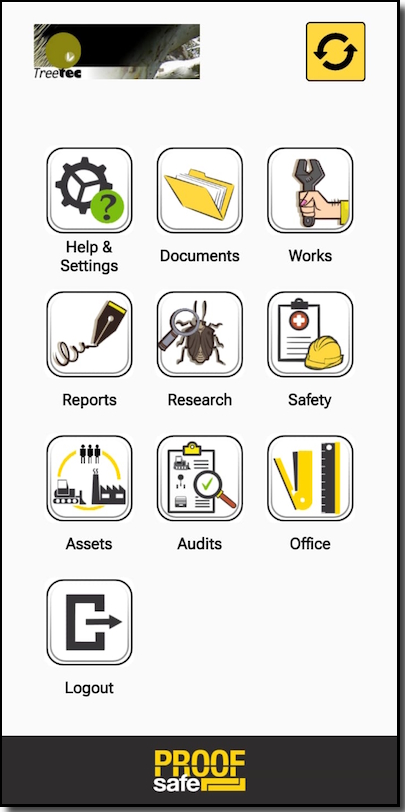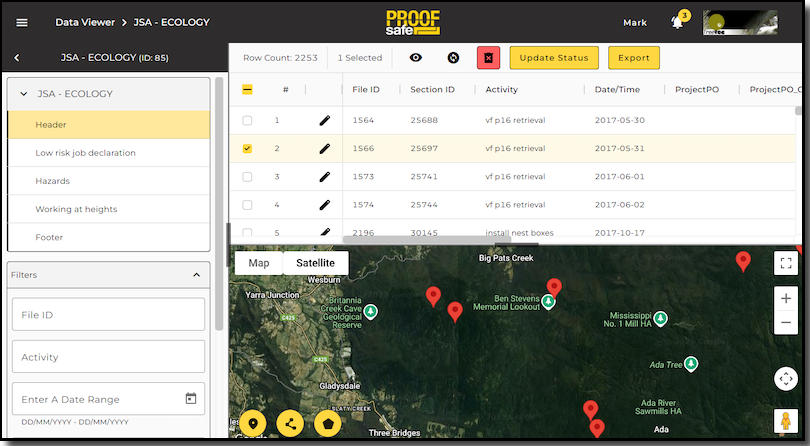ProofSafe: The Comprehensive Field Solution for Councils
ProofSafe is a powerful and flexible mobile data management system designed specifically for the diverse and complex needs faced by councils. It acts as a central hub, connecting council staff, contractors, and volunteers on a single platform. This ensures that field-collected information, whether from internal teams or external people, is efficiently amalgamated and ready for reporting.
In cases of incidents or hazards, a workflow can be established to follow an issue through to its conclusion, with each step requiring further data collection and validation. ProofSafe provides a single source of truth, eliminates secondary data entry, and brings efficiency to all council operations.

A Central Hub for All Council Operations
ProofSafe's strength lies in its ecosystem, which is designed to fill data collection and management gaps in your existing systems or operate standalone across all council operations.
Mobile App
Our intuitive app is the primary tool for data collection. It works completely offline, allowing staff and contractors to capture any data type, from photos and GIS coordinates to signatures and rich text, anywhere.
Web Interface & Server
All collected data is quickly synced to a central server when a connection is available. The web interface provides a powerful backend for data aggregation, analysis, and automated reporting.
API Integration
Our Application Programming Interface (API) allows for seamless, real-time two-way data transfer between ProofSafe and your existing council systems (e.g., asset management, finance). This means ProofSafe can be a powerful extension of your current software.
Connecting All Stakeholders
ProofSafe allows you to connect all stakeholders on a single network. Each council department, contractor, and volunteer group can have their own secure business setup, but all contribute to a central, shared dataset for the council.
Automated Reporting & Workflow
Data is instantly aggregated, allowing for automated reporting that saves countless hours of administrative work. Our system also supports a workflow model to track issues from initial reporting to final conclusion, ensuring nothing falls through the cracks.
Comprehensive Applications Across Council Services
ProofSafe's versatility makes it the ideal tool for managing the wide range of council responsibilities. Our forms are completely customisable, allowing them to fit any need with any question or list.

Public Space & Asset Management
Parks & Gardens
Conduct safety checks on playgrounds, equipment, and fencing. Perform inspections of trees for hazards, and record responsive works by contractors. Log watering schedules and report litter or graffiti.
Roads & Footpaths
Log defects like potholes and cracks. Record maintenance tasks like patching and sweeping. Inspect streetlights, signs, and bollards for damage, and track road closures.
Stormwater & Drainage
Inspect drains for blockages, log water quality samples, and report illegal dumping into waterways.
Public Buildings & Facilities
Conduct condition assessments of community halls and sports pavilions, log cleaning schedules, and report maintenance issues.
Public Pools
Perform daily water quality testing, record safety equipment checks, and conduct fencing audits.
Waste Management
Roadside Collections
Log missed bins and track specific waste stream volumes.
Illegal Dumping
Record locations, materials, quantities, and photographic evidence of illegal dumping incidents.
Waste Facilities
Log incoming waste types, volumes, and conduct spot checks for prohibited materials.
Workplace Safety & Incident Management
Hazard & Incident Reporting
Record the identification of new hazards and capture detailed accounts of all workplace incidents, accidents, or near-misses.
JSA / JSEA's
All teams, staff or volunteers record site specific hazards and controls before starting jobs and any site.
Safety Checklists
Use daily pre-start checks for vehicles and machinery, conduct site-specific inductions, and perform equipment safety audits.
Contractor Management
Keep activity logs and site diaries, and send text alerts when contractors are working on council property.
Environmental Health & Compliance
Inspections
Audit restaurants for food safety compliance, investigate public health nuisances, and track pest control applications.
Animal Management
Log animal sightings, record details of seized animals, and track animal registration checks or dog related attacks and incidents.
Building & Planning Compliance
Perform on-site inspections related to building permits, construction waste management, and compliance with planning conditions.
Bushfire & Emergency Management
Fire Hazard Inspections
Assess properties for fire risks and log vegetation clearance status.
Emergency Response
Collect field data during flood, fire, or storm events, including damaged infrastructure and road closures.
Community Services & Programs
Volunteer Activities
Register volunteer events, log hours, record completed tasks, and report any issues encountered.
Community Projects
Track attendance at outdoor workshops, log equipment usage, and record details of habitat projects like nest box installations.
Planning & Building Compliance
Permit Inspections
Conduct on-site verification that development and land use comply with approved planning and building permits.
Compliance Investigations
Respond to and investigate complaints about alleged breaches of planning or building acts.
ESM Audits
Inspect and log the maintenance of Essential Safety Measures like fire safety equipment and sprinklers.
Emergency Orders
Document field data related to dangerous buildings or land that pose an immediate risk to public safety.
